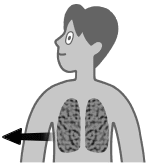 The Human Body’s Air Spaces The Human Body’s Air Spaces
|
|
|
In and around our bodies, there are many air spaces:
|
|
 |
① Sinus
② Mask
③ Middle Ear
④ Drysuit
⑤ Lung
⑥ Gas |
|
|
|
■Ear
Our external ear is separated by the eardrum in the middle ear from our inner ear. While we hear by way of our middle ear’s three ossicles, this tympanic cavity is not in direct contact with the atmosphere outside. Rather, the usually collapsed Eustachian tube connects from the chamber of the middle ear to the back of the pharynx. It is in our inner ear that we have our sense of hearing and sense of balance, by way of the connection of the cochlea to our brain.
|
|
 |
① Eardrum
② External ear
③ Three Ossicles (Hearing)
④ Inner Ear’s Three Semi-Circular Canals (Balance)
⑤ Cochlea (Hearing)
⑥ Eustachian Tube |
|
|
|
■Sinus Cavity
The sinus cavity consists of four, paired sites of air spaces on the skull in the region of our eyes, nose and cheeks. Sinuses are joined to the nasal cavity via small orifices called ostia.
These become blocked relatively easily by colds and allergic inflammation, causing sinusitis.
For divers, this can present a problem with pain due to unequal pressure ear equalization.
|
|
Sinus
 |
|
|
■Lungs
In the lungs there exist numerous air spaces called alveoli. Breathing occurs as long as the flow of air to and from the alveoli via the trachea is uninterrupted.
|
|
 |
 |
Lung Alveoli |
Lung |
|
|
|
■Other
Since dry suits are designed to keep water out, they form an air space around the body.
|
|
Air space due to dry suit
 |
|
|
Dental care, such as fillings, can create spaces in teeth.
|
|
Air spaces in teeth
 |
|
The wearing of a dive mask creates an artificial air space between mask and face.
Indigestion and drinking of carbonated drinks can create gas in the gastrointestinal system.
|

